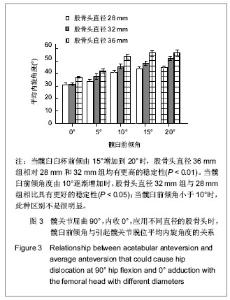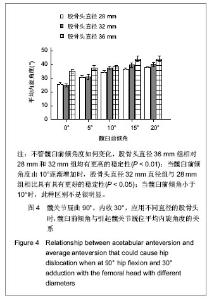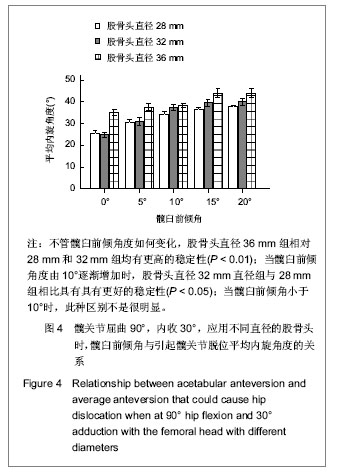| [1] Madey SM,Callaghan JJ,Olejnicza KJP, et al. Charnley total hip arthroplasty with use of improver techniques of cementing. The results after a minimum of fifteen years of follow-up.J Bone Joint Surg(Am).1997;19:53-64[2] 裘法祖,孟承伟.外科学[M].北京:人民卫生出版社,1998:791.[3] Borner M. Computer-assisted surgery. A critical evaluation. Unfallchirurg. 1997;100:689-691.[4] Digioia AM 3rd, Jaramaz B, Colgan BD. Computer assisted orthopedic surgery. Image guided and robotic assistive technologies. Clin Orthop.1998;(354):8-16.[5] Dennis DA, Channer M, Susman MH, et al. Intramedullary versus extramedullary tibial alignment systems in total knee arthroplasty. J Arthroplasty. 1993;8:43-47.[6] Burroughs BR, Hallstrom B, Golladay GJ, et al. Range of motion and stability in total hip arthroplasty with 28-,32-,38-,and 44-mm femoral head sizes.J Arthroplasty. 2005;20:11-19.[7] Woo R, Morrey B. Dislocations after total hip arthroplasty. J Bone Joint Surg Am. 1982; 64:1295-1306.[8] Berry DJ ,von Knoch M, Schleck CD, et al. Effect of femoral head diameter and operative approach on risk of dislocation after primary total hip arthroplasty. J Bone Joint Surg Am. 2005;87:2456-2463.[9] Geller JA, Malchau H, Bragdon C, et al. Large diameter femoral heads on highly cross-linked polyethylene. Clin Orthop Relat Res. 2006;447:53-59.[10] Nadzadi ME,Pedersen DR,Yack HJ,et al. Kinematics,kinetics, and finite element analysis of commonplace maneuvers at risk for total hip dislocation.J Biomech. 2003;36:577-591.[11] Jolles BM,Zangger P, Leyvraz PF. Factors pressdisposing to dislocation after primary total hip prosthesis. J Arthroplasty. 2002;17:282-288.[12] D’Lima DD, Urquhart AG,Buehler KO,et al. The effect of the orientation of the acetabular and femoral components on the range of motion of the hip at different head-neck ratios. J Bone Joint Surg(Am). 2000;82:315-321.[13] Widmer KH. Zurfluh B. Compliant positioning of total hip components for optimal range of motion.J Orthop Res. 2004; 22(4):815-821.[14] Beaule PE,Schmalzried TP,Udomkiat P,et al. Jumbo femoral head for the treatment of recurrent dislocation following total hip replacement .J Bone Joint Surg Am. 2002;84:256-263.[15] Bosker BH , Ettemma HB, Verheyen CCPM, et al. Acetabular augmentation ring for recurrent dislocation of total hip arthroplasty: 60% stability rate after an average follow-up of 74 months. Int Orthop. 2009;33:49-52.[16] Etienne A, Cupic Z, Charnley J. Postoperative dislocation after Charnley low friction arthroplasty . Clin Orthop Relat Res. 1978;132:19-23.[17] Lewinnek GE, Lewis JL, Tarr R, et al. Dislocations after total hip replacement arthroplasty .J Bone Joint Surg Am. 1978; 60:217-220.[18] Sakai T,Sugano N, Ohzono K, et al. Femoral anteversion, femoral offset ,and abductor lever arm after total hip arthroplasty using a modular femoral neck system. J Orthop Sci.2002;7(1):62-67.[19] Sakai T, Sugano N, Nishii T, et al. Optimizing femoral anteversion and offset after total hip arthroplasty,using a modular femoral ncek system: an experimental study. J Orthop Sci. 2000;5;489-494.[20] Turner RS.Postoperative total hip prosthetic femoral head dislocation:incidence, etiologic factors, and management. Clin Orthop. 1994;(301):196-204.[21] Spangehl MJ, Younger AS, Masri BA, et al. Diagnosis of infection following total hip arthroplasty. J Bone Joint Surg (Am).1997;79:1578-1588.[22] Garvin KL,Hanssen AD. Infection after total hip arthroplasty: past, pre-sent, and future. J Bone Joint Surg(Am).1995; 77:1576-1588.[23] Halley DK,Charnley J. Results of low friction arthroplasty in patients thirty years of age or younger. Clin Orthop. 1975; (112):180-191.[24] Collis DK. Long-term (twelve to eighteen-year )follow-up of cemented total hip replacements in patients who were less than fifty years oid: a follow-up note. J Bone Joint Surg (Am).1991;73:593-597.[25] Gebhard JS, Amstutz HC, Zinar DM, et al. A comparision of total hip arthroplasty and hemiarthroplasty for treatment of actue fracture of the femoral neck. Clin Orthop. 1992;282: 123-131.[26] Paterno SA, Lachiewicz PF, Kelley SS. The influence of patient-related factors and the position of the acetabular component on the rate of dislocation after total hip replacement .J Bone Joint Surg Am. 1997;79:1202-1210.[27] Yoshimine F,Ginbayashi X. A mathematical formula to calculate the theoretical range of motion for total hip replacement.J Biomech. 2002;35:989-993.[28] Yoshimine F. The influence of the oscillation angle and the neck anteversion of the prosthesis on the cup safe-zone that fulfills the criteria for range of motion in total hip replacements. The required oscillation angle for an acceptable cup safe-zone. J Biomech. 2005;38:125-132.[29] Soong M ,Rubash H, Macaulay W. Dislocation after total hip arthroplasty. J Am Acad Orthop Surg. 2004;12(5):314- 321.[30] Livermore J, Ilstrup D, Morrey B. Effect of femoral head size on wear of polyethylene of the polyethylene acetabular component. J Bone Joint Surg Am. 1990;72:518-528.[31] Bartz RL, Noble PC, Kadakia NR, et al. The effect of femoral component head size on posterior dislocation of the artificial hip joint.J Bone Joint Surg Am. 2000;82:1300- 1307.[32] 冯宗权,张健平,谭健韶,等.全髋关节置换术下肢等长探讨[J].中国矫形外科杂志, 2003,11(6):373-376.[33] 宋树春,陈成亮,潘玉林,等.全髋关节置换术后早期脱位的病因及防治[J].中国矫形外科杂志,2003,11(18):7-8.[34] Mcevoy A, Jeyam M, Ferrier G, et al. Synergistic effect of particles and cyclic pressure on cytokine production in human monocyte/nacriogages:proposed role in periprosthetic osteolysis. Bone. 2002;30:171-177.[35] Nadzadi ME,Pedersen DR, Callaghan JJ, et al. Effects of acetabular component orientation on dislocation propensity for small-head-size total hip arthroplasty. Clin Biomech (Bristol,Avon). 2002;17(1):32-40.[36] Schulte KR, Callaghan JJ, Kelley SS, et al. The outcome of charnley total hip arthroplasty with cement after a minimumtwenty-year follow-up: the results of one surgeon. J Bone Joint Surg(Am).1993;75:961-975.[37] Sariali E, Lazennec JY, Khiami F, et al. Mathematical evaluation of jumping distance in total hip arthroplasty influence of abduction angle, femoral head offset, and head diameter. Acta Orthop. 2009; 80:277-282.[38] Crowninshield RD, Maloney WJ, Wentz DH, et al. Biomechanics of large frmoral heads. Clin Orthop.2004; 429:102-107.[39] Kavanagh BF, Wallrichs S, Dewitz M, et al. Charnley low friction arthroplasty of the hip:twenty-year results with cement. J Arthroplasty. 1994;9:229-234.[40] Soong M, Rubash HE, Macaulay W. Dislocation after total hip arthroplasty. J Am Acad Orthop Surg. 2004;12(5):314-321. |



